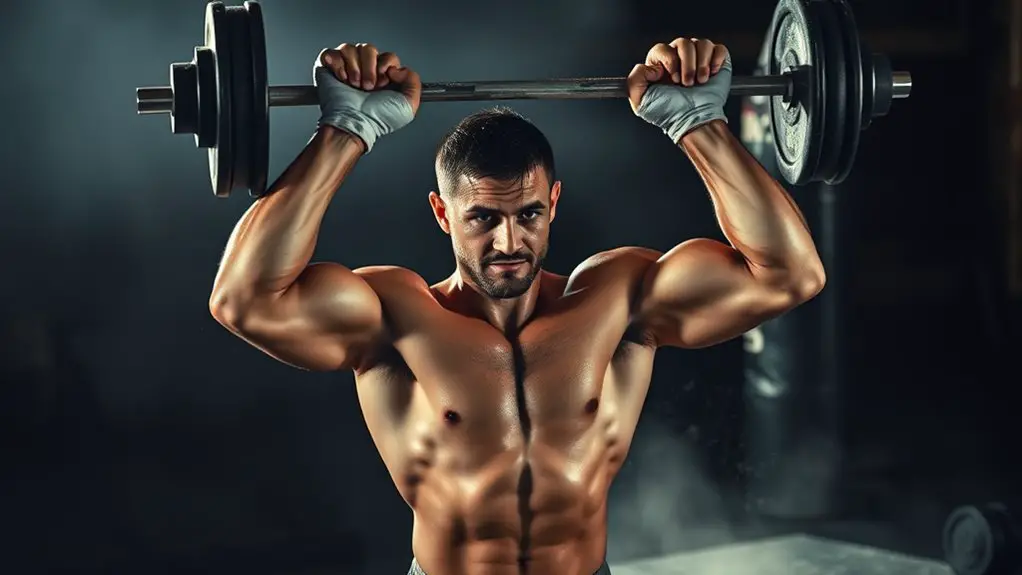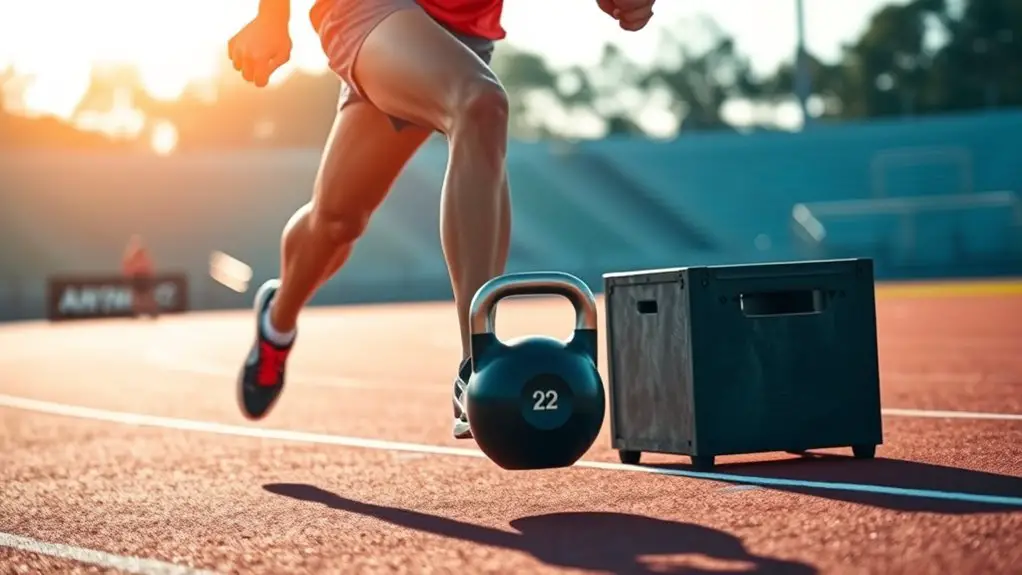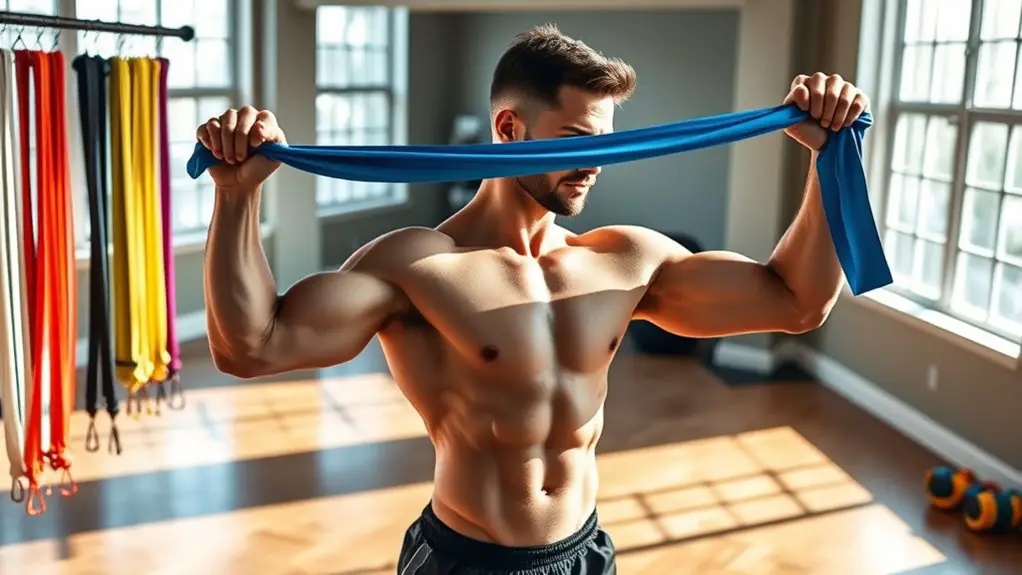To build knockout power in MMA, focus on strength training that includes compound movements like squats and deadlifts, which enhance overall power. Incorporate explosive exercises, such as plyometrics and Olympic lifts, to develop speed and coordination. Target your core with medicine ball throws and planks to improve stability and strength for striking. A well-rounded plan that adapts to your needs will help you maximize your training results. There's more to explore on effective training strategies.
Understanding Knockout Power in MMA
When it comes to mixed martial arts, understanding knockout power is essential for any fighter looking to excel. It's not just about brute strength; it's about mastering knockout mechanics and refining your striking techniques. You'll need to focus on how to generate force effectively, utilizing your body's kinetic chain.
Engaging your core and legs while maintaining proper stance will amplify your striking power. You'll find that the right combination of speed, timing, and precision can make all the difference in delivering a devastating knockout blow. Incorporating explosive movements into your training regimen can significantly enhance your punching power.
Practice techniques like hooks, uppercuts, and straight punches, ensuring each strike is executed with intent. The more you hone these skills, the more instinctive they'll become, allowing you to express your freedom in the octagon. Remember, it's not just about landing punches; it's about making every strike count and having the ability to end a fight decisively.
The Importance of Compound Movements
While many fighters focus on isolation exercises, incorporating compound movements into your strength training routine is essential for developing the overall power and functional strength needed in MMA. Compound exercises are multi-joint movements that engage multiple muscle groups simultaneously, providing significant compound exercise benefits. By using your entire body, you'll not only build strength but also improve coordination and stability, vital for effective striking and grappling.
These movements mimic the demands of a fight, helping you develop the explosive power necessary for knockouts. Think squats, deadlifts, and bench presses—each one requires synergy between different muscle groups, translating directly into your performance in the cage. Additionally, squats and deadlifts are particularly effective for engaging the posterior chain, which is vital for enhancing overall athletic performance.
When you prioritize compound movements, you'll notice improved athleticism and endurance, giving you the freedom to execute techniques with greater efficiency. So, embrace these powerful exercises and release your true fighting potential.
Plyometric Exercises for Explosive Strength
To enhance your explosive strength in MMA, plyometric exercises are a game-changer. They help develop the power you need to deliver knockout strikes and dominate your opponents. One effective method is using box jump techniques. By explosively jumping onto a sturdy box, you build leg strength and improve your agility. Focus on height and speed, and watch your performance soar.
Another fantastic option is medicine ball throws. These allow you to harness your core and upper body strength, mimicking the explosive motions you'll use in the cage. Try overhead throws or chest passes with maximum effort. Incorporating these plyometric exercises into your routine will unleash your potential and give you the edge you crave. Remember, it's all about training smart, staying consistent, and pushing your limits. Embrace the freedom that comes with strong, explosive movements, and you'll be well on your way to achieving knockout power in MMA. Additionally, these exercises are designed to improve nervous system efficiency, allowing for faster muscle responses and enhanced performance.
Incorporating Olympic Lifts Into Your Training
Plyometric exercises lay a solid foundation for explosive strength, but incorporating Olympic lifts can take your training to the next level. Mastering Olympic lift techniques not only enhances your power but also boosts your overall athletic performance. These lifts help you develop coordination, speed, and strength, essential for MMA fighters.
- Increased explosive power for quicker strikes
- Improved overall strength for grappling and takedowns
- Enhanced athleticism for better performance in the cage
Integrating Olympic lifts into your routine offers invaluable strength training benefits, allowing you to realize your full potential. Focus on exercises like the clean and jerk or snatch to engage multiple muscle groups, promoting functional strength. Remember, perfecting your technique is fundamental, so take your time to learn the lifts properly. With dedication, you'll see significant improvements that translate directly into your MMA performance, granting you the freedom to fight with power and agility. Additionally, proper technique is essential for maximizing explosive power and reducing the risk of injury during these lifts.
Targeting Core Strength for Enhanced Impact
Focusing on core strength is essential for any MMA fighter who wants to enhance their striking impact and overall performance. A strong core not only provides core stability but also allows you to generate that explosive rotational strength needed for powerful strikes. By incorporating specific exercises into your routine, you can maximize your effectiveness in the cage.
| Exercise | Focus Area | Benefits |
|---|---|---|
| Medicine Ball Throws | Rotational Strength | Increases explosive power |
| Planks | Core Stability | Enhances endurance and control |
| Russian Twists | Rotational Strength | Improves agility and flexibility |
Strengthening your core gives you the freedom to move dynamically and strike with precision. By prioritizing core workouts, you're setting yourself up for success, ensuring that every punch and kick packs a serious punch!
Utilizing Resistance Bands for Dynamic Training
Resistance bands are a versatile tool that can enhance your MMA training. By incorporating dynamic movement patterns, you can improve your strength and agility in a way that mimics real fight scenarios. Let's explore how to effectively use bands in your sparring sessions for maximum benefit. Additionally, resistance bands promote injury prevention and rehabilitation, enabling athletes to strengthen stabilizing muscles while maintaining flexibility.
Resistance Band Basics
Incorporating resistance bands into your training routine can elevate your strength and conditioning for MMA. These versatile tools come in various resistance band types, each offering unique benefits that can enhance your performance. Here's what you can expect:
- Improved Muscle Activation: Resistance bands force you to engage more muscle fibers, increasing your overall strength.
- Joint-Friendly Workouts: They provide resistance without the heavy loads, reducing strain on your joints.
- Portability: You can easily take them anywhere, ensuring you never miss a workout.
Dynamic Movement Patterns
Dynamic movement patterns are vital for MMA training, and using resistance bands can greatly enhance your performance. By incorporating bands into your routine, you'll improve dynamic flexibility and build explosive mobility, which are essential for delivering powerful strikes and executing quick maneuvers.
Start by anchoring the band to a stable surface and perform movements like lateral lunges or explosive chest passes. These exercises activate your core and engage multiple muscle groups, allowing you to move freely and efficiently.
As you progress, experiment with different band tensions to challenge yourself further. This dynamic training will empower you to release your knockout power in the cage, giving you the freedom to move without limitations. Embrace the resistance, and elevate your game!
Incorporating Bands in Sparring
Adding resistance bands to your sparring sessions can take your training to the next level. By incorporating band resistance, you can enhance your sparring techniques and develop explosive power. Here's how:
- Increased Muscle Engagement: Bands activate more muscle fibers, boosting strength and speed.
- Improved Stability: Resistance bands help you maintain balance during dynamic movements, reducing injury risk.
- Enhanced Punching Power: Feel the difference in your strikes as bands force you to generate more force and control.
Using bands while sparring isn't just about strength; it's about revealing your potential and embracing that freedom to move with agility. So grab those bands, mix up your routine, and watch your skills soar!
Developing a Comprehensive Strength Training Plan
While strength training is crucial for MMA athletes, developing a detailed plan tailored to your specific needs and goals is equally important. Start by evaluating your current fitness level and identifying your strengths and weaknesses. Use periodization strategies to structure your training into phases, focusing on different aspects like hypertrophy, strength, and power. This approach guarantees you're consistently challenging your body while avoiding plateaus.
Incorporate a variety of exercises, including compound lifts and explosive movements, to maximize your knockout power. Don't forget about recovery techniques; they're essential for preventing injuries and enhancing performance. Active recovery days, proper nutrition, and adequate sleep can make a world of difference. Additionally, focus on functional mobility to ensure you maintain agility and flexibility in your movements.
Listen to your body; if you're feeling drained, don't hesitate to adjust your plan. Embracing this flexibility will help you stay motivated and maintain the freedom to develop your skills while building the strength you need for success in the cage.
Frequently Asked Questions
How Often Should I Train for Knockout Power?
When you're aiming for knockout power, training frequency is key. You should aim for about 3 to 5 sessions a week, balancing intensity with adequate recovery time. Listen to your body; if you feel fatigued, it's okay to take a step back. Incorporating rest days not only prevents burnout but also enhances your performance. Remember, it's about quality over quantity, so focus on effective workouts that truly push your limits.
Can I Train for Power Without Weights?
Training for power without weights is like harnessing a storm—you can create immense energy with just your body. You can absolutely enhance your explosive strength through bodyweight exercises and plyometric drills. Think push-ups, jump squats, and burpees; they'll ignite your muscles and improve your speed. Embracing this freedom allows you to train anywhere, anytime, turning your environment into a powerful training ground. So, release your potential and feel the power grow within you!
What Should I Eat to Support Strength Training?
To support your strength training, focus on high-quality protein sources like chicken, fish, beans, and eggs. Timing your meals is essential—try to consume protein within an hour after your workouts for ideal recovery. Don't forget to include healthy carbs and fats to fuel your energy. Eating a balanced diet allows you the freedom to enjoy a variety of foods while ensuring your body gets what it needs to build strength effectively.
How Long Before a Fight Should I Start Training?
When it comes to training for a fight, you don't want to put the cart before the horse. Ideally, you should start your pre-fight preparation at least 6-8 weeks out. This training timeline allows you to build your strength and endurance while honing your technique. Keeping a steady pace throughout will guarantee you're not just ready, but also confident when stepping into the ring. So, give yourself the time to shine!
Are There Specific Warm-Up Exercises for Knockout Training?
Absolutely, there are specific warm-up exercises you can do for knockout training. Start with dynamic stretches to loosen up your muscles and improve your range of motion. Incorporate mobility drills, focusing on your hips, shoulders, and core. These will enhance your movement and power during training. Remember, the key is to feel free and fluid in your motions, so don't rush—take your time to thoroughly prepare your body for the workout ahead.




